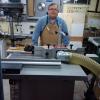My dad wants to add several 220v outlets in my garage. Iím tired of sharing a dryer outlet with 4 machines. My 5hp sawstop, 3hp jointer, And 5hp planer all have their own cords and 10-30 male plugs.
The plan was go add a few 10-30 outlets. Thoughts on that?
Question 2, what are these 4 wires for? Iím confused with wiring diagram and namplate. No way this motor needs a constant 110v so we figured to run 10awg cord and a 10-30 male plug.







 Reply With Quote
Reply With Quote



